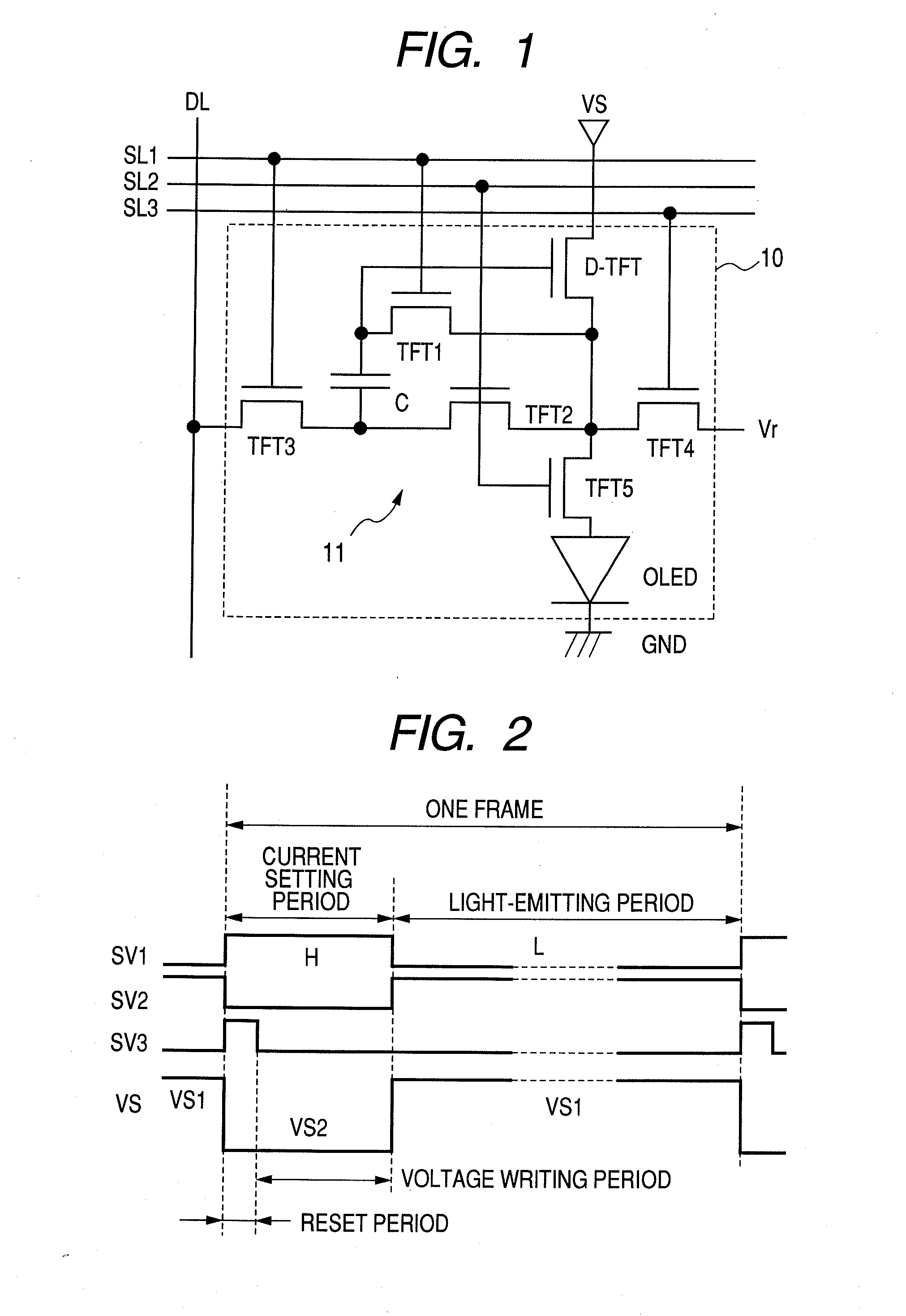Light-emitting display device
a display device and light-emitting technology, applied in the field of light-emitting display devices, can solve the problems of change in the characteristics of the tft due to electrical stress, the voltage-luminance characteristic of the oled element changes, and the oled element's voltage-luminance characteristic is changed temporally, so as to achieve high mobility, low power consumption, and high definition.
- Summary
- Abstract
- Description
- Claims
- Application Information
AI Technical Summary
Benefits of technology
Problems solved by technology
Method used
Image
Examples
first embodiment
[0064]FIG. 1 illustrates a pixel structure of a light-emitting display device using an OLED element (hereinafter, referred to as OLED display) according to a first embodiment of the present invention.
[0065]The OLED display according to this embodiment has each pixel 10 which includes an OLED element whose cathode terminal is connected (grounded) with a GND (ground) line (hereinafter, referred to as GND) and a drive circuit 11 connected with an anode terminal of the OLED.
[0066]The OLED has a structure in which a light-emitting layer made of an organic material is sandwiched between the anode terminal and the cathode terminal and emits light at a luminance corresponding to a current supplied from the drive circuit 11. The current supplied from the drive circuit 11 to the OLED is determined based on a control voltage from a data line.
[0067]The drive circuit 11 includes a driving transistor having a gate terminal, a source terminal, and a drain terminal, for driving the OLED, a capacito...
second embodiment
[0098]A pixel structure of a light-emitting display device using an OLED element according to a second embodiment of the present invention is similar to the pixel arrangement of the first embodiment. Note that, in this embodiment, the voltage VS2 of the power supply line VS is a constant value. When the threshold voltage of the D-TFT is expressed as Vt, “Vref−Vt>VS2” is satisfied. In other words, a highest voltage other than the voltage signals SV1, SV2, and SV3 of the first, second, and third scanning lines SL1, SL2, and SL3 is the reference voltage Vref of the reference voltage line Vr. The voltage VS2 of the power supply line VS is set to such a voltage that the D-TFT operates in the saturation region when the current is supplied to the OLED.
[0099]FIG. 3 is a timing chart illustrating an operation in this embodiment. The operation in this embodiment is similar to the operation in this first embodiment except that the voltage VS2 of the power supply line VS is the constant value a...
third embodiment
[0101]FIG. 4 illustrates a pixel structure of a light-emitting display device using an OLED element according to a third embodiment of the present invention. The description of the same constituent elements as the first embodiment is simplified or omitted.
[0102]The OLED display according to this embodiment has each pixel 10 which includes an OLED element whose cathode terminal is connected (grounded) with a GND (ground) line (hereinafter, referred to as GND) and a drive circuit 11 connected with an anode terminal of the OLED.
[0103]The drive circuit 11 includes a driving transistor having a gate terminal, a source terminal, and a drain terminal, for driving the OLED, a capacitor element C whose one end is connected with a gate terminal of a D-TFT, and multiple switch elements.
[0104]The driving transistor is comprised of an n-type TFT (hereinafter, referred to as D-TFT). The drain terminal of the D-TFT is connected with a power supply line VS and the gate terminal thereof is connected...
PUM
 Login to View More
Login to View More Abstract
Description
Claims
Application Information
 Login to View More
Login to View More - R&D
- Intellectual Property
- Life Sciences
- Materials
- Tech Scout
- Unparalleled Data Quality
- Higher Quality Content
- 60% Fewer Hallucinations
Browse by: Latest US Patents, China's latest patents, Technical Efficacy Thesaurus, Application Domain, Technology Topic, Popular Technical Reports.
© 2025 PatSnap. All rights reserved.Legal|Privacy policy|Modern Slavery Act Transparency Statement|Sitemap|About US| Contact US: help@patsnap.com



